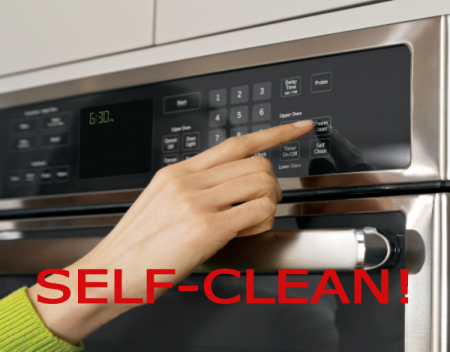Blog Categories
- Appliances Four
- Athletic Seating
- Auto Helpers
- Automated Stock Rooms
- Chocolate Four
- CuraFlo
- Damaged Goods Dating
- Flood Insurance Four
- Game Addict
- Hi Tech Pest Control
- HVAC Four
- Medical Labels Four
- Mental Health Four
- National CWS
- Promotional Ideas
- Seguros Lara Insurance
- Stem Cell Worx
- The Hidden Truth
- The Last Refuge
- The Mozilla Blog
- Video Editing Four
- Web Design Dev
- Website Development Four
- Windows Blog
Oven Cleaning Options

Despite our best efforts, we all have experienced a mess in the oven one way or the other. Whether it’s cheese melting off a pizza, or a cobbler oozing over the baking sheet, spills can leave quite the mess. When shopping for a new range, it’s important to know the available options you have for cleaning. Read on to discover the different ways you can clean your appliance.
Self-Clean Ovens
The self-clean cycle is meant to be a convenient time-saving feature. The oven is cleaned by heat, at temperatures greater than when you’re cooking. During this cycle, the oven is heated to about 880 degrees Fahrenheit, or 471 degrees Celsius. At this temperature, food soils inside the oven will begin to decompose, leaving small amounts of ash behind. These leftover ashes can be wiped out easily with a wet cloth.
Depending on the amount of food soil, this cycle could take from one and a half hours to three hours. A slight odour may be noticed the first few times you run this cycle. Do not use pieces of aluminium foil to catch spillovers. You may leave self-clean racks in your oven, but you must remove any stainless steel racks.
Self-Clean Ovens with Steam
Steam Clean allows for quick cleaning of smaller food spills at temperatures lower than the standard self-clean feature. Simply pour 1 cup of water into the bottom of a cool oven. Close the door and choose Steam Clean. This cycle lasts roughly 30 minutes and loosens up the grime in the oven. Once the cycle is complete, wipe out the moisture with a soft cloth. Since Steam Clean uses a lower temperature, the oven door does not automatically lock, as it would normally do in Self-Clean mode. Steam Clean does not involve any chemicals, meaning that pans and racks can remain in the oven when cleaning.
Manual Clean Ovens
Manual Clean ovens do not include any self-clean or steam clean features and require physical cleaning by hand. Frequent wiping with soap and water (especially after cooking meat) will prolong the time between major cleanings.
For minor food spills; soap, water, and a scouring pad should be everything you need. Stronger soils might require a commercial oven cleaner made for use in a usual oven clean. Standardly cleaning an oven can be made easier when using household ammonia. Place ½ cup in a shallow glass container in the cold oven overnight. The fumes from the ammonia will help loosen the burned-on grease and food.
Re Posted From: Oven Cleaning Options

Despite our best efforts, we all have experienced a mess in the oven one way or the other. Whether it’s cheese melting off a pizza, or a cobbler oozing over the baking sheet, spills can leave quite the mess. When shopping for a new range, it’s important to know the available options you have for cleaning. Read on to discover the different ways you can clean your appliance.
Self-Clean Ovens
The self-clean cycle is meant to be a convenient time-saving feature. The oven is cleaned by heat, at temperatures greater than when you’re cooking. During this cycle, the oven is heated to about 880 degrees Fahrenheit, or 471 degrees Celsius. At this temperature, food soils inside the oven will begin to decompose, leaving small amounts of ash behind. These leftover ashes can be wiped out easily with a wet cloth.
Depending on the amount of food soil, this cycle could take from one and a half hours to three hours. A slight odour may be noticed the first few times you run this cycle. Do not use pieces of aluminium foil to catch spillovers. You may leave self-clean racks in your oven, but you must remove any stainless steel racks.
Self-Clean Ovens with Steam
Steam Clean allows for quick cleaning of smaller food spills at temperatures lower than the standard self-clean feature. Simply pour 1 cup of water into the bottom of a cool oven. Close the door and choose Steam Clean. This cycle lasts roughly 30 minutes and loosens up the grime in the oven. Once the cycle is complete, wipe out the moisture with a soft cloth. Since Steam Clean uses a lower temperature, the oven door does not automatically lock, as it would normally do in Self-Clean mode. Steam Clean does not involve any chemicals, meaning that pans and racks can remain in the oven when cleaning.
Manual Clean Ovens
Manual Clean ovens do not include any self-clean or steam clean features and require physical cleaning by hand. Frequent wiping with soap and water (especially after cooking meat) will prolong the time between major cleanings.
For minor food spills; soap, water, and a scouring pad should be everything you need. Stronger soils might require a commercial oven cleaner made for use in a usual oven clean. Standardly cleaning an oven can be made easier when using household ammonia. Place ½ cup in a shallow glass container in the cold oven overnight. The fumes from the ammonia will help loosen the burned-on grease and food.
Re Posted From: Oven Cleaning Options

